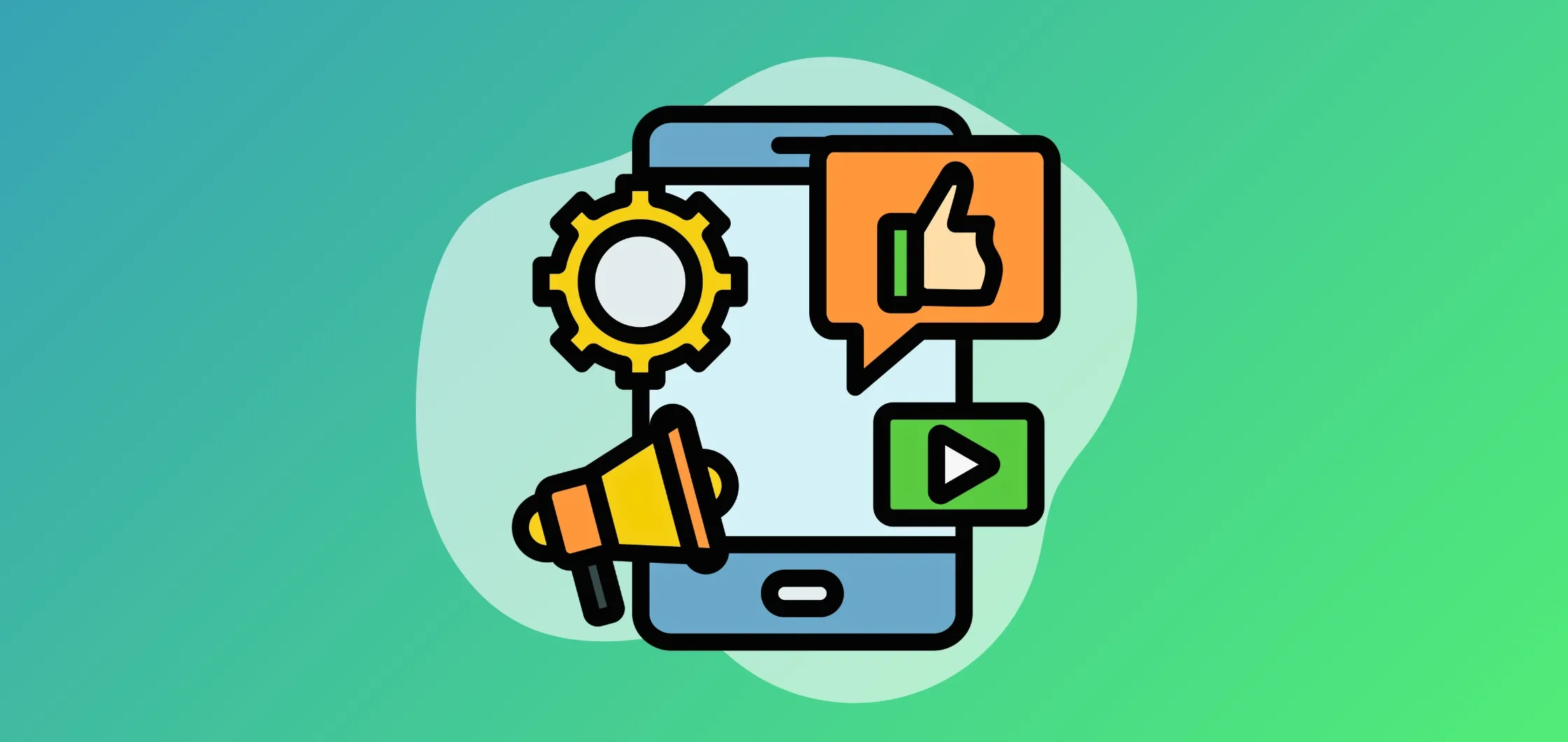Facebook Ads represent one of the most powerful tools in a marketer’s arsenal, thanks to their precision targeting and massive reach. With an average conversion rate of 9.21 percent across industries, they offer substantial potential to drive sales, leads, and brand awareness.
However, while launching Facebook Ads campaigns is simple, understanding the ROI requires a nuanced strategy. Conversions rarely happen in a vacuum, and Facebook’s native reporting often provides an incomplete picture. A customer might click a Facebook ad, browse your site, leave, then return days later via Google Search or an email—so if you only credit Facebook, you’re missing the bigger picture. To truly understand your Facebook Ads ROI, you need to look beyond the Facebook dashboard and take a full multi-channel view.
How to Set Up Facebook Campaigns for Accurate ROI Tracking
The best starting point for healthy ROI is having sturdy technical foundations.
That means implementing the right pixel configurations, defining clear conversion events, and structuring your campaigns to enable accurate measurement.
Privacy changes—like Apple’s iOS 14.5 update and increased browser restrictions—have significantly limited Facebook’s ability to track user behavior. Users can now opt out of tracking, so fewer events are captured. As a result, Facebook Ads ROI can appear lower or become harder to measure unless you take a multi-channel attribution approach to fill in the gaps.
Book a Demo
Understand the precise impact of each marketing touchpoint and track “true” CAC, ROAS, and ROI on marketing spend with The Attribution Platform.
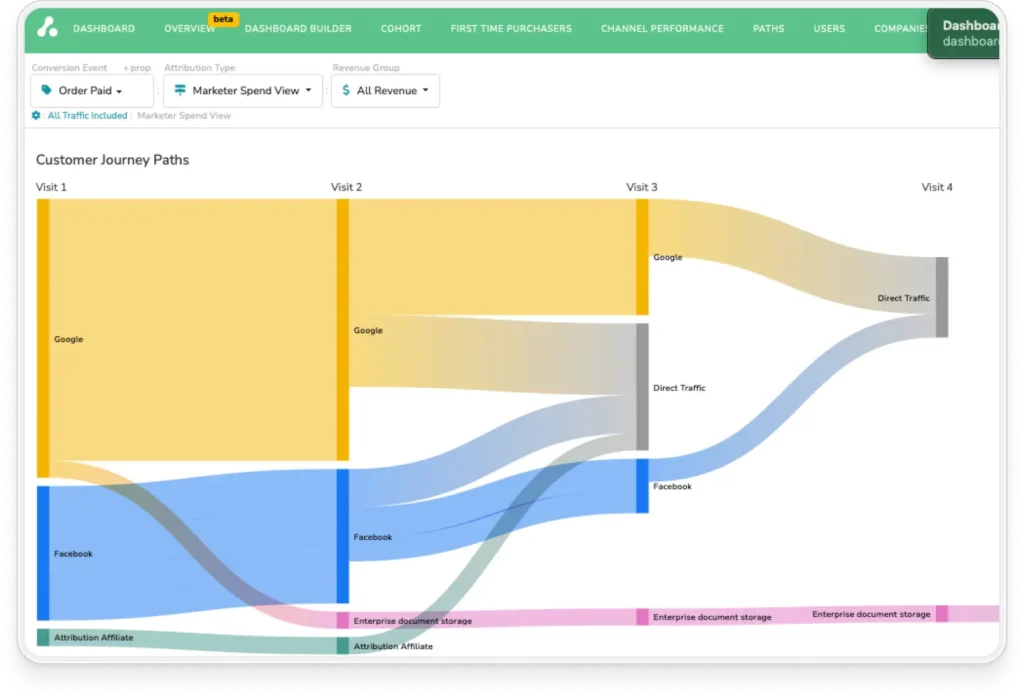
Follow these steps to get your technical setup for Facebook Ads on point:
Configure the Meta Pixel and Conversion Events
Your first step is to install a functional Meta pixel.
- Install the pixel across key pages of your website. This tiny snippet of code tracks user behavior across your site.
- Add the Meta pixel code to your site header.
- Check that it loads on all relevant pages, especially conversion hotspots like checkout, lead forms, or sign-up flows.
- Configure conversion events.
- In Meta Events Manager, choose your critical events (e.g. purchase, lead, or add to cart.
- Under “Aggregated Event Measurement”, rank these events by business impact to ensure proper attribution when data is limited.
- Test for accuracy. Misfires, duplicate events or missing parameters can wreck your reporting.
- Use the Meta Pixel Helper to check for:
- Pixel firing on each page
- Correct event names and parameters
- Duplicate or missing events
- Use the Test Events tab in Events Manager to simulate real user interactions and catch issues early.
- Layer in server-side tracking for even better accuracy and resilience.
- Implement the Conversions API to send event data directly from your server. This bypasses browser restrictions (like ad blockers and iOS opt-outs), improving data accuracy and event match quality.
Create Effective Custom Audiences for Targeting
Smart audience targeting is a goldmine for high-ROI Facebook campaigns.
Start by building custom audiences based on website visitors, customer lists, or content engagement. Then segment these users by funnel stage: serve educational content to top-of-funnel visitors and conversion-focused offers to bottom-of-funnel users.
Aligning your message with each user’s intent can dramatically increase conversions. After implementing a precise pixel setup which based custom audiences on purchase behaviour, Seltzer Goods saw a 3x return on ad spend in just three months.
To scale your reach, tap into lookalike audiences modeled on your highest-value converters. For ROI-driven campaigns, it’s best to build these lookalikes from bottom-of-funnel actions, such as purchases or trial sign-ups.
It’s important to remember that with data privacy regulations tightening, all audience data must be handled transparently. That means using hashed customer data, respecting consent, and prioritizing user trust every step of the way.
Implement Consistent Tracking Parameters
If your tracking is messy, your ROI insights will be too. Without consistent tracking parameters, comparing performance across platforms is almost impossible.
Here are some best practices for keeping your tracking consistent:
- Use UTM Parameters: Add UTM tags to every campaign URL so that tools like Google Analytics can identify where your website traffic is coming from. Without them, you’re flying blind.
- Standardize naming conventions: Use a clear, structured format for campaign, ad set, and ad names (e.g., T0F_Prospecting_Shoes_Video1) so your data stays organized and easy to analyze.
- Automate your tagging process: Streamline your workflow with Google Tag Manager, Facebook’s {{fluid}} dynamic URL parameter and attribution platforms that enforce consistent logic and help maintain reliable data.
Small fixes go a long way; clean data equals clearer insights, which means smarter budget decisions and stronger ROI.
How to Measure Facebook Ads ROI
Calculating ROI for Facebook Ads sounds simple: (Revenue from Facebook Ads – Facebook Ad spend) ÷ Facebook Ad spend = ROI.
But the challenge lies in getting the inputs right. Poor data = misleading results.
To measure accurately, you’ll need to:
- Track revenue across the full customer journey, not just last-click.
- Use multi-touch attribution to avoid overvaluing Facebook’s self-reported ROAS.
- Avoid double-counting conversions.
- Include all ad costs–not just media spend, but also creative, tools, or agency fees (if applicable).
- Measure over the right timeframe, depending on your sales cycle.
Let’s break down the best ways to measure your ROI:
Essential Metrics to Track for Facebook Ads
To evaluate the impact of your Facebook Ads, you need to understand all the metrics that drive action.
Engagement Metrics:
- Click-Through Rate (CTR) indicates how compelling your ad is to your audience.
- A CTR above 1.5% typically suggests strong creative and targeting.
- A low CTR can signal ad fatigue, irrelevant messaging, or poor targeting.
- Cost Per Click (CPC) shows how much you’re paying for each interaction.
- Aim for a low CPC + high CTR. This combination means your ad is engaging and cost-efficient.
Great ads will always grab attention, but clicks alone don’t pay the bills. To evaluate whether that traffic is delivering real value, focus on these metrics:
Conversion Metrics
- Conversion Rate represents the % of users who complete a desired action (purchase, signup, etc.) after clicking your ad.
- A strong rate shows good alignment between ad, landing page, and offer.
- Cost Per Acquisition (CPA) reveals how much you’re paying for each customer or lead.
- If your CPA exceeds customer lifetime value (LTV) or average order value (AOV), your campaign isn’t sustainable.
Value Metrics
- Return on Ad Spend (ROAS) measure the revenue generated per dollar spent on ads.
- A 4x ROAS = $4 earned for every $1 spent—strong, but that’s only good if your margins support it.
- Return on Investment (ROI) is a broader measure of profitability.
- Includes all campaign-related costs: creative production, tools, labor–everything it takes to run the campaign.
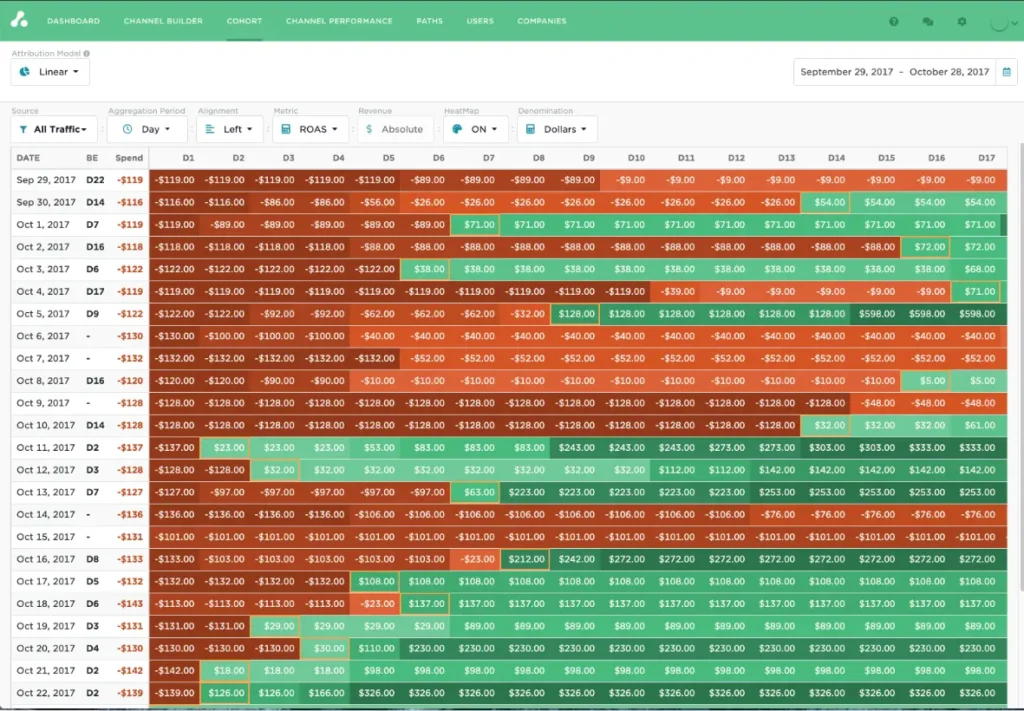
Combining and monitoring all metrics with comprehensive conversion tracking software will help to identify what’s working, where to optimize, and whether your campaigns actually drive growth.
Industry Benchmarks for Facebook Ads ROI
Facebook ad performance varies widely by industry—knowing your vertical’s benchmarks will help to set realistic goals and spot opportunities.
| Industry | Average Facebook Ads ROAS Range | Notes |
| E-commerce | 3x – 4x | Highly competitive, variable by product category, liable to fast trend cycles |
| B2B | 2x – 5x | Longer sales cycles and higher deal values |
| Services | 2x – 4x | Often local or niche audiences |
| SaaS | 4x – 7x | High LTV, longer sales funnel, strong retargeting potential |
Your goals should also reflect your margins, sales process, and LTV.
How to use benchmarks effectively:
- Know your vertical. Compare your results to industry-specific ranges, not generic averages.
- Factor in seasonality. Expect ROAS fluctuations around holidays, events, or product launches.
- Adjust for trends. Stay flexible–market shifts can push performance above or below typical benchmarks.
Understanding these nuances ensures you’re not chasing unrealistic numbers and can optimize campaigns in context.
Comparing Facebook Ads ROI to Other Marketing Channels
Facebook ads can deliver impressive ROI—but how do they compare to other platforms like Google or LinkedIn? To make smart budget decisions, you need to make apples-to-apples comparisons across channels.
Here’s a quick breakdown of some of the characteristics of other Ad platforms:
| Channel | Avg. CTR | Strengths |
| Facebook Ads | 0.9 – 1.5% | Visual targeting, scalable reach, ideal for DTC, retargeting, and mid-funnel engagement |
| Google Search | 3-6% | High-intent queries, great for bottom-of-funnel conversions and branded search |
| Google Display | 0.35-1% | Broad awareness, remarketing at low CPC, good for top-of-funnel campaigns |
| LinkedIn Ads | 0.4-0.6% | Precision B2B targeting, strong for lead gen, high-ticket services, and SaaS |
| Instagram Ads | 0.8-1.2% | Strong visual appeal, seamless shopping, great for lifestyle and branded content |
| TikTok Ads | 1.5-3% | High engagement, ideal for product discovery and younger audiences |
No single channel wins every time. When comparing platforms, use consistent attribution models and timeframes, with benchmarks like ROAS to guide allocation. Facebook might drive discovery and influence while Google closes the sale, so avoid double-counting. First-party tracking or multi-touch attribution models may paint a more accurate picture. Cross-channel ROI clarity ensures you’re not just spending—but scaling smart.
5 Strategies to Optimize Campaigns Based on ROI Insights
It takes more than simple metrics to track campaign performance. You’ll need a date-driven approach focused on ROI.
A high-performing strategy is developed over time, from knowing when to scale, when to stop, and how to tweak every part of the funnel for maximum return.
To put these principles into action, let’s break down some key strategies:
1. Test with Small Budgets Before Scaling
You don’t need a massive budget to find what works, but you do need planning and precision. Tests provide early insights that are reliable and scalable, and reduce spending on underperforming ads.
Here are some best practices which will help you gain ROI insights without overspending:
- Set a testing baseline. To get meaningful results, your sample size must be sufficient. Aim for 1000+ impressions per variation to ensure statistical validity.
- Use minimal viable budgets. Try to spend $20–$50 per variation over 3-5 days, depending on CPM and funnel stage.
- Target stable audience sizes. Use audiences of at least 100,000 users to reduce data volatility.
- Test one variable at a time. Isolate elements like headlines, images, CTAs, or placements so you know what’s moving the needle. Social media attribution will be key to helping you track performance shifts.
- Know when to scale. Once you see a 2x+ ROAS with a statistically valid CPA, scale gradually–no more than 20% per day–to avoid resetting the learning phase, and keep scaling your PPC ROI.
- Factor in attribution windows. Meta’s default (7-day click, 1-day view) can skew early signals–track ROI across the full conversion window.
- Leverage AI tools. Meta reports brands using AI see 22% better efficiency and $4.52 return per $1 spend. Use automation to identify and fund winners faster.
2. Use Engagement Metrics to Predict and Improve ROI
CTR and engagement metrics aren’t conversions, but they highlight ad resonance and signal what’s working early. You can use engagement to guide initial decisions.
- Track CTR as a pulse check:
- >1.5% CTR typically indicates good performance.
- <1% means it’s time to revisit copy, creative or targeting.
- Bridge engagement with conversion:
- High CTR but low conversion? There’s likely a disconnect between the ad and the next step in the funnel–don’t let a good ad lead to a weak landing page.
- Find winning audiences:
- Break down CTR and interaction by segment.
- Combine with behaviors (video views, add-to-cart, etc.) to fine-tune targeting.
- Know when to ignore engagement:
- In bottom-of-funnel campaigns, conversion rate outweighs CTR. A 0.8% CTR with a 5% conversion rate beats a 2% CTR with a 1% conversion rate every time.
3. Optimize Landing Pages
No matter how well an ad performs, your landing page closes the deal. A disconnection between the ad and the landing page often stunts ROI. Your landing page must instill trust, echo the ad’s message, and provide a clear next step.
The average landing page conversion rate is 5.89 percent, but a good goal is to aim for around 10 percent.
To turn your landing page into an asset that maximizes every click, make sure you:
- Message match: Ensure landing page headlines, visuals, and CTAs match the ad. Confusion or bait-and-switch kills conversion rates.
- Test continuously: Use tools like Google Optimize to A/B test landing page variants. Start with high-impact elements: headline, CTA, layout, and form fields.
- Measure performance: Track bounce rate, session duration, and conversion rate using Meta Pixel Event Tracking and Google Analytics. Use heatmaps to analyze scroll depth and user behavior.
4. Use Funnel-Stage Specific Strategies
Different funnel stages require different goals, creatives, and expectations.
To optimize results, tailor your strategy to each stage:
- Top-of-funnel (awareness): Focus on reach and engagement. These campaigns rarely deliver immediate ROI but prime audiences for later conversion. Retain them with tracking pixels and remarketing.
- Mid-funnel (consideration): Target users who’ve engaged, clicked an ad, watched a video, or visited a page. Lead magnets, webinars, or product demos help nurture this segment.
- Bottom-of-funnel (conversion): Focus on retargeting high-intent users, e.g., cart abandoners or product viewers. These campaigns drive the majority of ROI and are critical for budget efficiency.
Each funnel stage contributes to the customer journey. Top-of-funnel campaigns generate awareness and seed future demand. Mid-funnel strategies build trust and move users closer to purchase. Bottom-of-funnel tactics convert interest into revenue.
5. Retarget to Boost Overall ROI
Retargeting converts interest into action, but only if you do so thoughtfully. Research suggests people are 70% more likely to convert if you’ve retargeted them.
Start with behavior-based retargeting. Segment users by their actions, like product page views, cart abandonment, or lead form opens. Then, tailor your creative and timing to match each user’s intent.
For more precision, layer in advanced segmentation. Break audiences down by device, time on site, content viewed, or scroll depth to align messaging with user behavior.
Avoid ad fatigue at all costs. Showing the same ad 10 times doesn’t increase Facebook marketing ROI. Instead, use frequency caps (1–2 per day) and refresh creatives weekly for active retargeting pools.
Finally, measure incrementality and don’t assume every retargeted conversion is incremental. You can use lift testing or tools to measure the incremental impact of your retargeting spend.
How Attribution Measures True Facebook Ads ROI
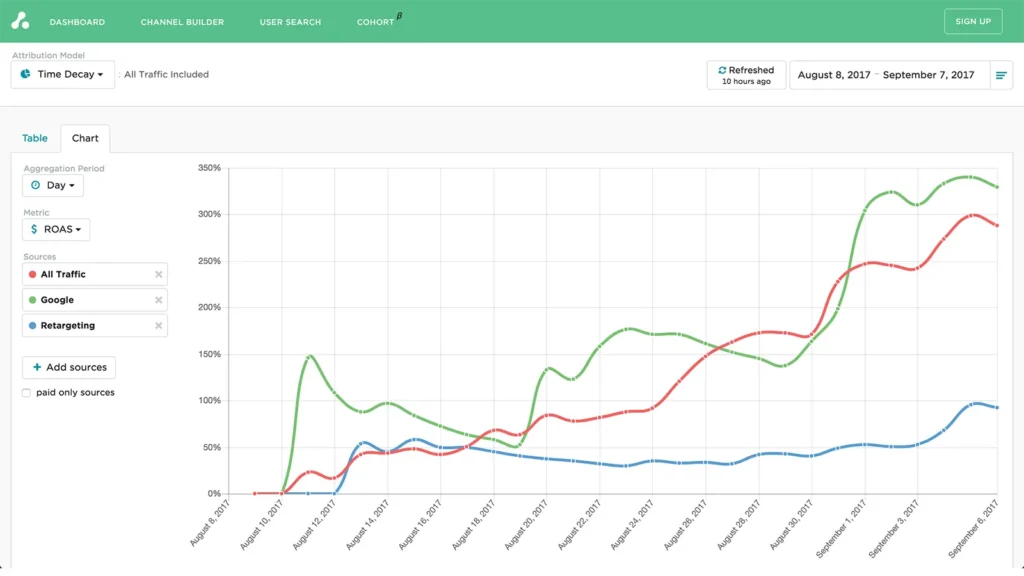
Beyond Facebook’s native metrics, the Attribution Platform provides a complete and precise picture of Facebook Ads ROI.
The Attribution Platform integrates directly with Facebook Ads, pulling in spend data, automating tagging with its built-in {{fbaid}} parameter, and syncing user-level data with downstream revenue. By combining these signals, Attribution enables custom attribution models that properly credit Facebook’s role in multi-touch journeys.
The result is a unified, cross-channel view of performance that gives Facebook neither too much nor too little credit.
Sign up and try Attribution today — pinpoint CAC by channel, audit funnels and conversion rates, scale revenue-driven content marketing, measure affiliate LTV and CAC (and more).
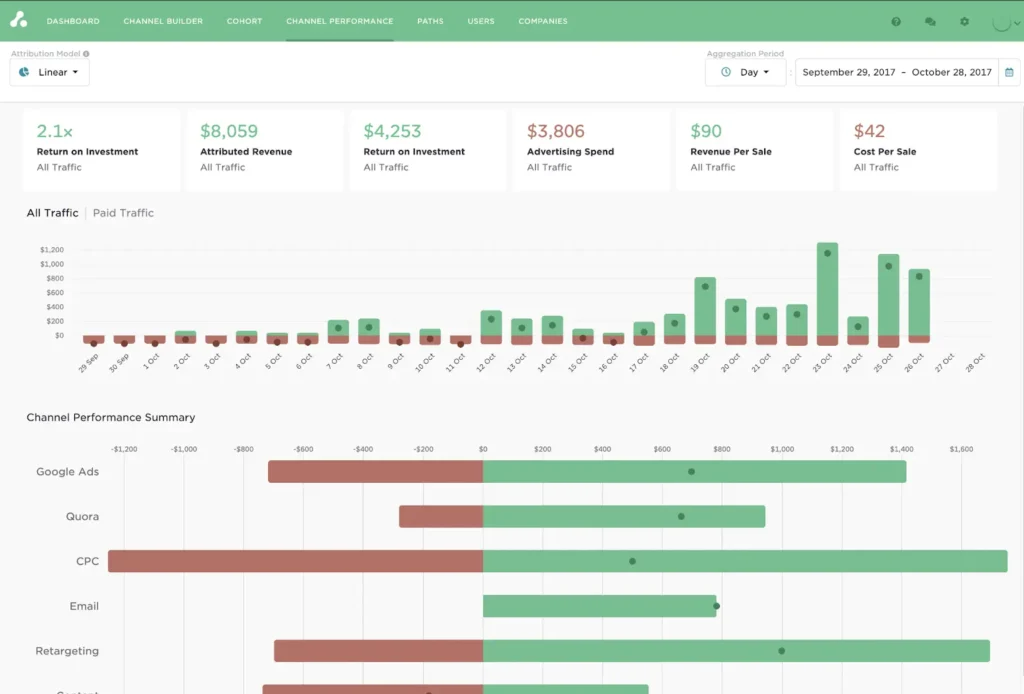
Facebook Ads ROI FAQs
What is a good ROI for Facebook ads?
It depends on your industry, product, and goals. E-commerce businesses might target 3x or 5x ROAS. B2B campaigns often see lower short-term returns due to longer sales cycles.
How long does it take to see ROI from Facebook ads?
It varies. Direct-response campaigns may show ROI within days, while full-funnel strategies can take weeks or months to deliver returns, especially for high-consideration products.
How can I improve my Facebook ads ROI quickly?
Start by tightening targeting, improving ad creative, and optimizing landing pages. Test small changes methodically and reallocate the budget toward high-performing segments. Also, cross-check your attribution settings to ensure you’re capturing full value.
